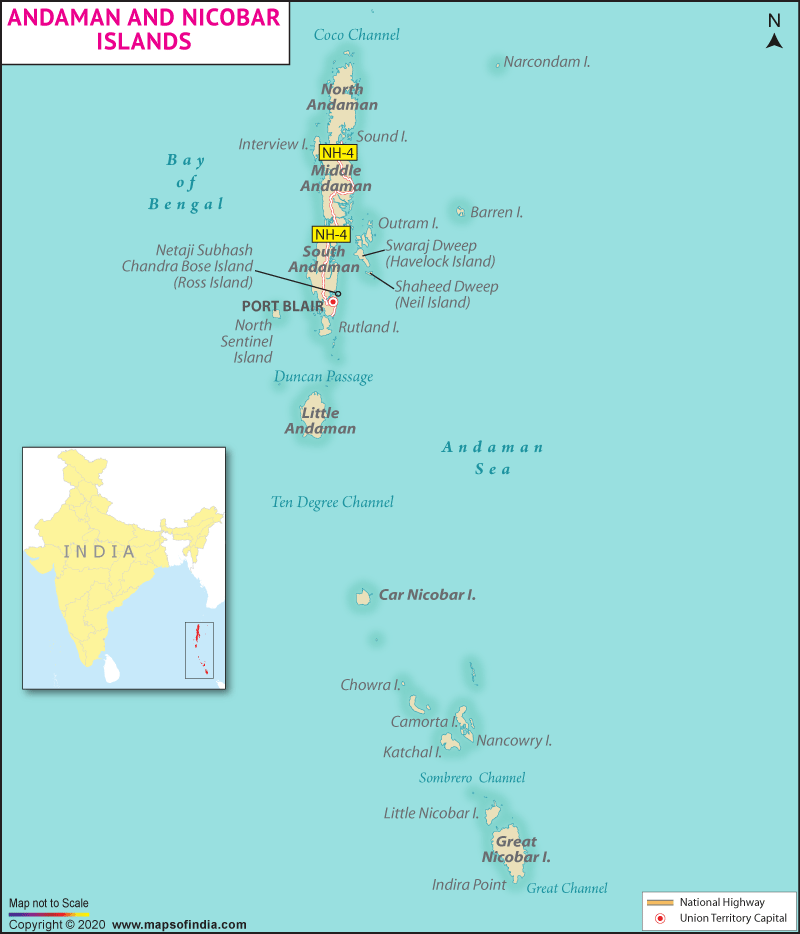Great Nicobar Project
About Great Nicobar Island
- Great Nicobar is the southernmost and largest of the Nicobar Islands, a sparsely inhabited 910-sq-km patch of mainly tropical rainforest in southeastern Bay of Bengal.
Andaman and Nicobar Islands
|
- Indira Point which is India’s southernmost point is located on this island
- It is hilly and covered with lush rainforests that are sustained by around 3,500 mm of annual rainfall.
- The rainforests and beaches host numerous endangered and endemic species including the giant leatherback turtle, the Nicobar megapode, the Great Nicobar crake, the Nicobar crab-eating macaque, and the Nicobar tree shrew.
- Great Nicobar has two national parks, a biosphere reserve.
- The island is home to two tribal communities — the Shompen and the Nicobarese and a few thousand non-tribal settlers.
Shompen tribes
Nicobarese
|

Why in news?
- There has been opposition to the Great Nicobar Island Project stating its impact on the island’s natural environment and on the indigenous tribes living on the island.
Features of the Great Nicobar Island Project
- The Great Nicobar Island Project was unveiled by NITI Aayog in March 2021.
- It is a ₹72,000 crore plan called ‘Holistic Development of Great Nicobar Island at Andaman and Nicobar Islands’.
- The mega infrastructure project is proposed to construct an International Container Transshipment Terminal (ICTT), a greenfield international airport with a peak hour capacity to handle 4,000 passengers, a township, and a gas and solar based power plant spread across 16,610 hectares.
- It is being implemented by the Andaman and Nicobar Islands Integrated Development Corporation (ANIIDCO).
Strategic Importance
- Great Nicobar is close to the Malacca Strait, the main waterway that connects the Indian Ocean to the Pacific, and the ICTT is expected to allow Great Nicobar to participate in the regional and global maritime economy by becoming a major player in cargo transshipment.
- A proposed greenfield city will tap into both the maritime and tourism potential of the island.
- The Bay of Bengal and Indian Ocean region are of vital strategic and security interest to India as the Chinese People’s Liberation Army Navy seeks to expand its footprint across the region. Thus, close surveillance of the entire area around the archipelago, and the building up of a strong military deterrence at Great Nicobar is of vital importance to India’s national security.
Challenges related to the project
- Environmental Concerns
-
-
- The proposed infra upgrade has been opposed on grounds of the threat it poses to the ecology of the islands.
- The project requires the diversion of about 130 sq km of forest land and the felling of around 10 lakh trees.
- It is feared that the port project will destroy coral reefs with spinoff effects on the local marine ecosystem, and pose a threat to the terrestrial Nicobar Megapode bird and leatherback turtles who nest in the Galathea Bay area.
-
- Impact on Indigenous Tribes
-
- The project may have a potentially devastating impact on the Shompen tribes who live in close connection with the island’s natural environment.
- For the Shompen, one of the biggest threats is disease. Since the Shompen have had little contact with the outside world, they haven’t yet developed immunity to infectious diseases that affect India’s general population. Some Shompen settlements also overlap with the areas the NITI Aayog has proposed to be used for the transshipment terminal.
Sources
Tag:Andaman and Nicobar Islands, Andaman and Nicobar Islands Integrated Development Corporation (ANIIDCO), cluster of 836 islands, Great Nicobar Project, Holistic Development of Great Nicobar Island at Andaman and Nicobar Islands, Indira Point, Nicobarese, Particularly Vulnerable Tribal Group, Shompen, Ten Degree Channel.
Subscribe
Login
0 Comments
